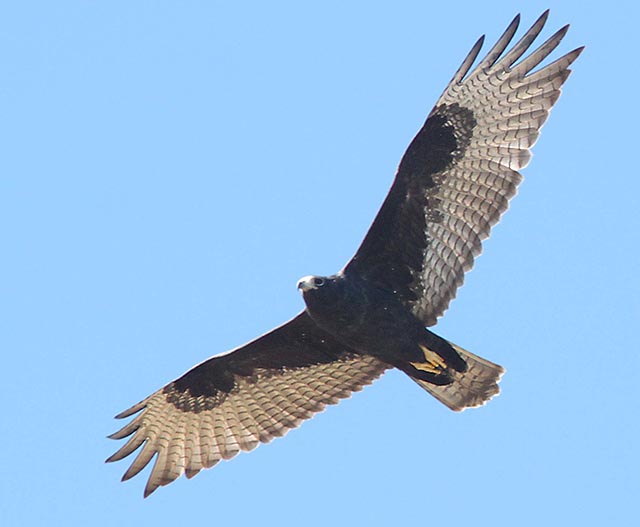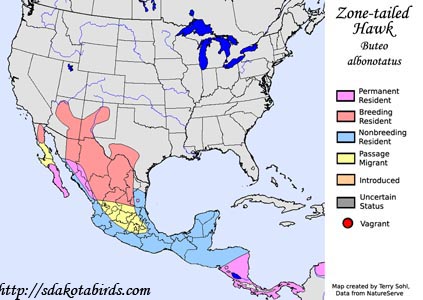Zone-tailed Hawk
Buteo albonotatus
| Length: 20 inches | Wingspan: 50 inches | Seasonality: Non-resident in South Dakota |
| ID Keys: Dark overall, broad lighter banding on tail. Very similar in appearance to Turkey Vulture while in flight. | ||
 The
Zone-tailed Hawk is a large raptor that only reaches the far southwestern
U.S. during the summer months. They are perhaps best known by birders
for their extremely close resemblance to
Turkey Vultures while in a soaring flight, and indeed, Zone-tailed Hawks
will sometimes fly in the midst of soaring Turkey Vultures. It is
thought that this mimicry provides Zone-tailed Hawks with a hunting
advantage, as the small prey animals pursued by Zone-tailed Hawks typically
have little to fear from Turkey Vultures, and aren't likely to flee upon the
sight of a soaring Turkey Vulture.
The
Zone-tailed Hawk is a large raptor that only reaches the far southwestern
U.S. during the summer months. They are perhaps best known by birders
for their extremely close resemblance to
Turkey Vultures while in a soaring flight, and indeed, Zone-tailed Hawks
will sometimes fly in the midst of soaring Turkey Vultures. It is
thought that this mimicry provides Zone-tailed Hawks with a hunting
advantage, as the small prey animals pursued by Zone-tailed Hawks typically
have little to fear from Turkey Vultures, and aren't likely to flee upon the
sight of a soaring Turkey Vulture.
Habitat: Found in a variety of open habitats, typically in areas with scattered trees for nesting. In the U.S. portion of their range, they are most often found in riparian areas with tall streamside trees, with open country nearby.
Diet: Feeds on a variety of small animals, including small mammals, lizards, snakes, large insects, birds, and frogs.
Behavior: Soars in flight like a vulture, even using a vulture's typical v-shaped wing position. When prey is spotted, usually Zone-tailed Hawks will slowly circle closer, maintaining the vulture mimicry, before diving in a strong attack.
Nesting: The nest of a Zone-tailed Hawk is typical of that for a Buteo hawk, a large platform of sticks, typically lined with smaller twigs. The nest is built in a tall tree, or much more rarely, on a cliff ledge. The female alone incubates the eggs, but both the male and female help to raise the young.
Song: Zone-tailed Hawks have a high scream similar to some other Buteo hawks.
Migration: Nearly all birds in the U.S. portion of their range move southward into Mexico or Central America for the winter. Zone-tailed Hawks are permanent residents in parts of Central and South America.
Interactive eBird map: Click here to access an interactive eBird map of Zone-tailed Hawk sightings
Similar Species: Distinctive in plumage from other Buteo hawks. Most often confused with Turkey Vulture while in flight. Also similar to Common Black-Hawk.
Conservation Status: There are currently no perceived major threats to Zone-tailed Hawk populations, and Birdlife International cites it as a species of "Least Concern". Populations in the United States appear to be increasing.
Further Information: 1) Hawkwatch International - Zone-tailed Hawk
2) AudubonGuide - Zone-tailed Hawk
3) WhatBird - Zone-tailed Hawk
Photo Information: Public Domain photo by Alan Schmierer
Additional Photos: Additional Photos Coming Soon!!
| Click below for a higher-resolution map |
 |
| South Dakota Status: Non-resident in South Dakota |
Additional Zone-tailed Hawk Photos (coming soon!!)
